Abstract
This analysis of the material degradation processes most commonly found in half-timbered walls with earth infill in Spain is part of a much broader line of research aiming to analyze, catalogue and understand their constructive techniques, state of conservation, and transformation in order to propose conservation guidelines. Systematic data collection and statistical analysis of material damage for 268 half-timbered walls with earth infill have made it possible to identify the most common degradation processes. The effect of these processes on this type of technique, as well as the relationship between them and any possible conditions contributing to their frequency, were examined. Almost half of the sample studied presents some type of material degradation, most frequently surface erosion, while the presence of vegetation is the least common pathology. Any future decisions about the most suitable maintenance and conservation actions should be based on the conclusions reached here concerning the frequency and scope of these degradation phenomena.
1. Introduction
For centuries the degradation of traditional architecture, understood as a material object threatened by degradation processes due to physical, chemical, and natural factors, has been limited by the continuous maintenance of the occupants, who knew the traditional techniques and had access to the necessary local materials [1]. However, social issues such as the rural exodus and the depopulation of towns and villages have led to the abandonment of buildings and the disappearance of traditional maintenance activities [2]. Equally, industrialization and the introduction of new constructive materials, combined with the lack of valorization of this type of architecture, has promoted the development of transformation dynamics and interventions which have not taken into consideration the conservation of traditional features or material and structural compatibility [3].
When proposing the analysis of the state of conservation of any traditional constructive technique it should be kept in mind that visible damages in the elements studied are the manifestation, at a specific point, of complex degradation mechanisms. These may have been active and can worsen causing more serious damage if the original cause is not treated [4]. These manifestations can be classified depending on the scope; they are considered to be alterations when they do not cause the physical, chemical and mechanical properties of the material, while they are considered to be degradations when they involve worsening of these properties. Therefore, alterations are intrinsic to the passing of time but pose no threat to the survival of the building, while degradations require interventions principally to resolve the cause or causes, thus preventing the continued development of these mechanisms or their effects worsening.
This study examines the most common material degradation processes in Spain which affect half-timbered walls with earth infill, a constructive technique where the function of the timber framework is mostly structural, while the needs for enclosure, rendering and insulation in the walls are resolved with earth [5]. By definition, this technique combines several materials so that the material degradation of half-timbered walls with earth infill is the result of both the mechanisms characteristic of earth infill and those linked to the timber structure. Moreover, the heterogeneous materials, complex geometry, and lack of compatibility in terms of the deformability of materials results in a broad casuistry of structural defects to be studied in a later phase [6].This analysis examines half-timbered walls where the timber fulfils the structural function and the formwork sections are filled with monolithic techniques (Figure 1a), with brick infill (Figure 1b), or even woven walls (Figure 1c) where the formwork sections are filled with light screens of braided plant fibre on nailed timber boards rendered in mortar.
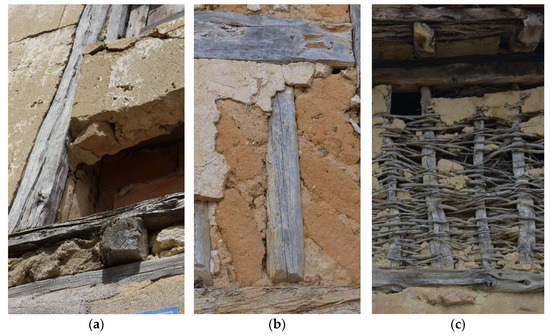
Figure 1.
Different material variants identified in the study: (a) half-timbered wall with monolithic infill, based on the piling or pouring of earth into formwork; (b) half-timbered wall with brick infill, based on piling prefabricated pieces like adobe; (c) woven wall based on the use of light screens made up of braided plant elements or rigid boards.
Buildings with these techniques have been located mostly in the north-western part of the country (Figure 2), in particular in mountainous areas above 500 masl, where the climate favours the growth of optimal trees for construction [7]. This also implies a relatively low average temperature and a higher pluviometry that may favour the development of several atmospheric lesions. The 83 localities where they have been located have a very small population, generally less than 500 inhabitants. This can imply both a greater lack of maintenance and the presence of spontaneous interventions with inadequate materials and techniques due to the absence of access to qualified specialists and technicians. The buildings studied are mostly dwellings located in urban centres and generally correspond to row or corner buildings with 2 or 3 storeys. The urban context in which they are located promotes a lower exposure to atmospheric events such as rain and wind. The fact that the great majority of the mixed walls studied are located on top of another wall or plinth made of more resistant materials, such as ashlar and masonry, also reduces the possible influence of humidity from the ground.
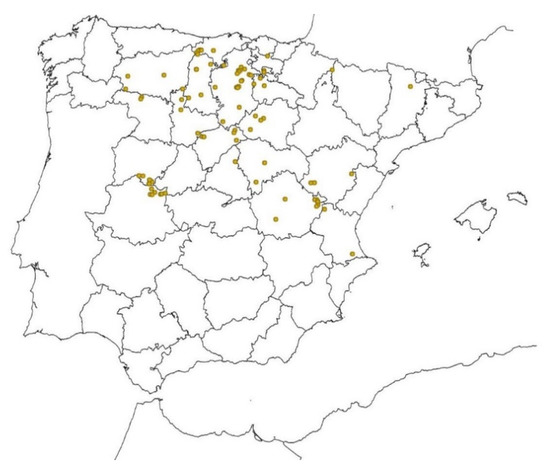
Figure 2.
Geographical distribution of the 83 sites where earth and wood mixed walls have been located.
2. Objectives and Methodology
This text is part of wider research which aims to define the different types of half-timbered walls with earth infill found throughout Spain, as well as to study the state of conservation and transformation dynamics taking place. The aim is therefore to understand constructive techniques and analyze current conditions in order to establish guidelines for conservation interventions and valorization. This text will analyze the frequency and occurrence of certain material degradation processes in this type of technique in order to propose the most suitable future maintenance and conservation actions.
The research methodology is based on the detailed analysis of the largest possible number of case studies, selected from the earthen buildings documented in the research project “SOS-Tierra: La restauración y rehabilitación de la arquitectura de tierra en la Península Ibérica. Líneas guía y herramientas para una intervención sostenible.” In total, 268 case studies were selected for analysis from 2973 photographs catalogued as half-timbered walls with earth infill.
To ensure a clear scientific objective analysis, a study fiche was used, divided into three major blocks: general information on the building; specific data on the constructive technique of the wall studied; and an analysis of the state of conservation and transformation dynamics [8]. The fiches have been filled in using database management software, which allows a global analysis to be made, to compare some data with others and to draw objective and statistically valid conclusions. In particular, the data compiled in this last section of the fiche made it possible to reach statistically valid objective conclusions on the occurrence and causes of the most common degradation processes presented below.
The main limitation of this research is geographical, as it is impossible to visit each and every Spanish site to corroborate the existence or absence of half-timbered walls. Moreover, direct visual analysis through photographs has limited the study to external façades or partition walls. This limited the number of conclusions reached on the use and state of conservation of this type of technique in the interior partitions of buildings. The material damages analyzed were classified according to the agent causing them, whether atmospheric, biological or anthropic. The occurrence of each of the pathologies detected has been correlated with other weathering processes and the possible conditions which may favour or reduce their effect, as well as with direct contact with the ground or the presence of renderings. Equally, the incidence of each degradation on the material variants identified has also been analyzed.
3. Material Degradation
The term material degradation refers to physical and chemical changes in the material due to atmospheric, biological, and anthropic agents. Direct and constant exposure to atmospheric agents is the main cause of damage in earth infill, so that the conservation of this type of technique is greatly dependent on the existence and maintenance of different protection elements including eaves, plinths, and renderings [9]. Although initially the combined action of rainwater and solar radiation only causes surface deterioration in timber, it encourages rot and attacks from xylophagous insects, endangering structural conservation [10].
In this research we carried out a detailed analysis of 15 different types of pathologies (Figure 3), classified depending on the agent causing them. On average these damages appear in 42% of the cases studied, with surface erosion being the most commonly studied pathology while the presence of vegetation is the least frequent. These visible effects are a specific phase of a degradation mechanism which continues to evolve until its causes can be reversed or their effect lessened. They may first manifest as specific phenomena to be replaced by others as they advance. For instance, water pooling initially takes the form of damp stains, but if unchecked it may provide optimum conditions for the timber to rot, finally generating structural damage unless it is reversed.

Figure 3.
Mean presence of the different material degradation phenomena analyzed.
3.1. Degradations Caused by Atmospheric Agents
Direct exposure to elements such as rain, wind, and humidity in the ground are the main source of degradation detected, affecting the entire sample in varying degrees. As exposure to these atmospheric agents is inevitable, the influence and development of associated weathering processes is greatly conditioned by the existence and correct maintenance of traditional protection elements [11].
Analysis of the degradations due to atmospheric agents shows that the most frequent are the erosion of infill which occasionally progresses to cause the loss of volume, discoloration, dehydration, and deterioration of cracks in timber elements (Figure 3). However, the presence of damp is also widespread in the sample studied, and in the long term it causes the disaggregation and erosion of the infill, as well as the surface deterioration of the timber and the proliferation of xylophagous insects and rot.
3.1.1. Damp Stains
Both earth and timber are hygroscopic materials which tend to absorb water, either due to capillarity from the ground, rain infiltrating through walls or condensation caused by environmental humidity. Increased humidity in the earth mass can lead to initial chromatic alterations and stains on the surface of the infill (Figure 4).

Figure 4.
Damp stains in the lower part of a half-timbered wall in Ayllón (Segovia), where the eaves do not protect from the incidence of rain.
This may go on to cause a softening of the mass, which weakens and temporarily recovers its original plastic state [12]. Equally, it can cause surface erosion which can lead to a considerable loss of section, in turn bringing about structural stability issues. These may cause the timber to change size, favouring the proliferation of phenomena such as rot, fungi, and xylophagous insects and affecting the resistance of timber elements [13].
Damp stains were detected in 74% of the case studies analyzed (Figure 3). When considering the various materials of these walls, damp stains appear in 75% of walls with monolithic infill, in 68% of walls with brick infill, and in 33% of walls woven with light screens (Figure 5a). While the rate of occurrence in half-timbered walls is similar, it is almost halved in the case of woven walls. Woven walls are mainly used in agricultural buildings more in need of ventilation, and the material of the screens is thinner than those of other techniques, with a rendering that is not always completely watertight [14]. This type of degradation can appear at the base of walls in direct contact with the ground as the water found in the soil can rise through capillarity both in the earth mass and in the timber elements. They can also appear in the upper sections of walls if the eaves are not in good condition or large enough to provide protection from the rain.
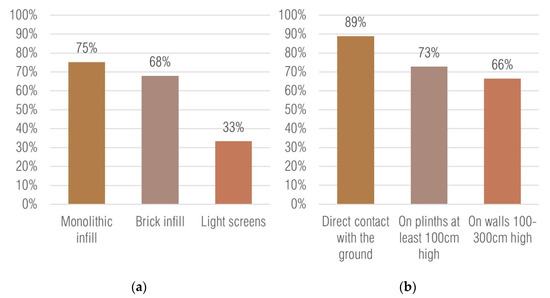
Figure 5.
Analysis of the occurrence of damp stains in the walls studied: (a) presence of damp stains with half-timbered walls with monolithic infill, with brick infill and with light screens; (b) presence of damp stains in half-timbered walls in contact with the ground, built on low plinths and on higher walls.
As half-timbered walls are traditionally built on other walls built with more resistant materials such as masonry or ashlar in order to prevent rising damp [7], damp stains are found in 89% of the few cases built directly on the ground, a percentage which decreases progressively with the existence of plinths or walls (Figure 5b).
3.1.2. Efflorescence
The presence of damp can entail the migration of salts found in the ground or the infill mass which, when water evaporates, are deposited and crystallize forming efflorescence on the exterior surface or internal crypto-efflorescence. The increase in volume resulting from the crystallization of salts generates internal forces in the material. After several crystallization and dissolution cycles this favours both surface disaggregation in the case of efflorescence and internal disaggregation of the material in the case of crypto-efflorescence [15].
Although efflorescence can result in serious damage such as a loss of cohesion and detachment in the infill, it has only been detected in 9% of the walls studied (Figure 3). Regarding the various materials, this pathology appears in 12% of walls with monolithic infill, in 6% of walls with brick infill, and in no woven walls with light screens (Figure 6a). Although these salts can originate in the earth mass of the infill, the ground or the atmosphere, the main source tends to be the cement mortar used for repairs or rejointing [16]. In the sample studied, 29% of cases rendered in cement mortar display efflorescence, in contrast with 16% of cases with lime or gypsum mortar rendering and 4% of earth mortars (Figure 6b).
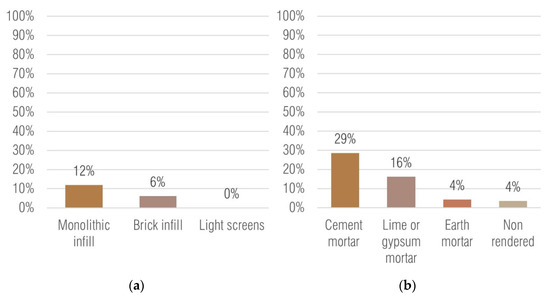
Figure 6.
Analysis of the occurrence of efflorescence in the walls studied: (a) presence of efflorescence in half-timbered walls with earth infill, with brick infill and with light screens; (b) presence of efflorescence depending on the renderings used, either cement mortars, lime or gypsum mortars, earth mortars or walls left bare.
Moreover, it was detected that 62% of cases with efflorescence are linked to the use of cement for repairs or rejointing (Figure 7). Considering the effect of the use of cement mortars in the appearance of this type of degradation it should be noted that all the cases of woven walls studied are rendered with traditional mortar—lime, gypsum and earth—and no efflorescence has been observed in any case.

Figure 7.
Efflorescence on a half-timbered wall in Reinoso (Burgos), where concrete mortar has been used to repair the encounter with the lower wall.
3.1.3. Surface Erosion
Erosion is the loss of material to varying degrees and may be caused by the action of rain on contact with the walls or the action of particles from wind, although also due to the crystallization of salts or the wall gelifraction caused by damp [15]. Despite being the most common pathology, specifically affecting 97% of cases studied (Figure 3), in most cases it is surface erosion which has not yet affected the material or structural conservation of elements (Figure 8).

Figure 8.
Different degrees of erosion in a half-timbered wall in Ayllón (Segovia).
The distribution of erosion in the various materials is rather homogeneous, as it has been identified in 93% of cases with earth infill, 87% of cases with brick infill, and 81% of cases with light screens (Figure 9a). The presence of renderings provides a layer which is more resistant to the impact of rain and air-driven particles, and easier to repair and replace so that the occurrence of erosion is slightly lower in rendered walls (Figure 9b). Future research phases should assess the different degrees of erosion or areas where this occurs to obtain a more detailed analysis of the correlation between these degradation and the material variants.
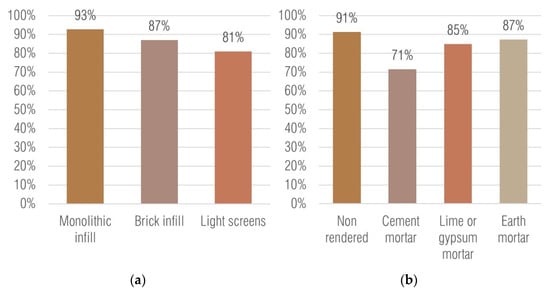
Figure 9.
Analysis of the occurrence of erosion on the walls studied: (a) presence of this pathology depending on the material variant of the infill; (b) presence of this pathology depending on the renderings used, whether cement mortars, lime or gypsum mortars, earthen mortars, or bare walls.
In addition to erosion due to rain and wind, in areas reaching temperatures below zero, excessive humidity content in the earth infill can cause erosion through gelifraction due to the increase in volume from water freezing [15]. As 60% of the sample is found in mountain areas, while 66% is located above 700 masl, it is very possible that freezing is a relevant factor in the erosion of these walls. When comparing the geographical distribution of the case studies with the map showing the annual mean for the number of days with freezing temperatures between 2002 and 2012, the range observed is between 40 and 150 days of freezing temperatures for the area studied [17].
3.1.4. Loss of Volumetry
The combined effect of wind and rain and possible mechanical aspects caused by people, animals, or vegetation moved by the wind initially lead to the disaggregation and surface erosion of earth infill. If these conditions persist over time the loss of material continues to cause further losses (Figure 10) which may endanger the structural stability of the element [18].

Figure 10.
Volumetric loss of the monolithic filling of a half-timbered wall in Cepeda (Salamanca).
This degree of damage has generally been detected in 48% of the case studies (Figure 3). The distribution of occurrences is similar in the different material variants, with 46% of earth infills affected, 42% of brick infills affected, and 48% of light screens affected (Figure 11a). From observing the combination of surface erosion and loss of volumetry it can be seen that approximately half the cases of erosion have evolved to cause volumetric losses in specific areas, more notably in light screens where the earthen mortar layer can become more easily detached from the auxiliary substructure of timber and plant fibres (Figure 11b).

Figure 11.
Analysis of the occurrence of loss of section in the walls studied: (a) presence of this pathology depending on the material variant of the infill; (b) combined presence of erosion and loss of section on the half-timbered walls studied depending on the types of infill.
3.1.5. Discoloration and Dehydration of Timber
Exposure of timber to solar radiation causes the timber to dry and the lignin to degrade (Figure 12), first making it darken to a brownish hue which over time becomes more gray as the cellulose is left exposed [19]. This degradation, which occurs slowly and is worsened by the combined action of water and solar radiation, can be calculated at between 1 and 13 mm per century depending on the type of timber and exposure [20].

Figure 12.
Discoloration and dehydration of timber of a half-timbered wall in Calatañazor (Soria).
This extremely common pathology has been detected in 90% of case studies (Figure 3), in 83% of earth infills, in 80% of brick infills, and in 90% of light screens (Figure 13a). This pathology is characteristic of timber and does not affect its conservation or resistance. Its spread is conditioned not so much by the material but by its surroundings, the maintenance of the buildings it is used in, and above all the presence of a protective rendering on the timber. Renderings are devised as a protective layer against these degradation agents and although in northern European climates timber is not usually rendered but allowed to breathe and dry better, in southern Europe it is usual to render both the infill and the timber to protect them from solar incidence and other atmospheric agents [21]. Thus, observing the incidence of dehydration and chromatic alteration in relation to the presence and scope of renderings, this is greater in cases where they are not rendered and in cases where the rendering only covers the infill (Figure 13b). It was also observed that when the rendering covers the structure and the infill this alteration only affects the specific areas where the rendering has become detached, leaving the timber exposed.

Figure 13.
Analysis of the occurrence of the chromatic alteration and dehydration of timber in the walls studied: (a) presence of this alteration depending on the material variant of the infill; (b) presence of this alteration depending on the presence and extent of the rendering.
3.1.6. Deterioration of the Wood Cracks
Fissures or cracks may appear in the timber (Figure 14), either in an axial or radial direction. However, radial cracks pose a threat to structural use, as they can cause collapses with no prior warning [22]. These cracks can be caused by stress due to unequal growth in the tree itself or to a differential drying of the timber caused by climate factors such as solar radiation, freezing or wind.
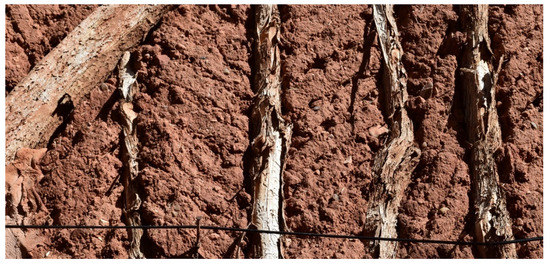
Figure 14.
Significant deterioration of the wood cracks in a half-timbered wall in Ayllón (Segovia).
The deterioration of cracks was identified in 87% of case studies (Figure 3) and is the third most common pathology. Its distribution is similar in the various materials (Figure 15a), as it depends less on the material variant and more on the timber structure and its exposure to atmospheric agents. Although the longitudinal cracks are not usually a mechanical risk this type of alteration can become a point of entry for damp, fungal rot, and the attack by xylophagous insects which in the long term can endanger the conservation of timber [23]. Rot was identified in approximately a third of cases with this type of pathology (Figure 15b), and this may also be due to the accumulation of water due to infiltration and the placement of the elements in construction.
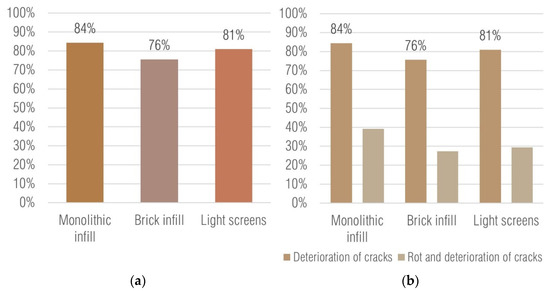
Figure 15.
Analysis of the occurrence of deterioration of cracks in the timber in the walls studied: (a) presence of this alteration depending on the material variant of the infill; (b) presence of this alteration depending on the presence and extent of the rendering.
3.1.7. Chipping and Gaps in the Rendering
Equally, this type of pathology is detected in 45% of the sample studied (Figure 3). However, this figure increases to 73% when considering only the cases showing renderings, whether with earth or rubble infill with a protective layer of rendering (Figure 16) or woven walls where the mortar adds rigidity and insulates the interior.

Figure 16.
Chipping and gaps in the lime or gypsum mortar rendering of a half-timbered wall in Santibañez de Ayllón (Segovia).
Regarding the incidence of this degradation depending on the material variety of the infill (Figure 17a), it is important to consider this in relation to the number of cases with rendering. Earth infills display this type of degradation in only 27% of total cases and in 69% of rendered cases, mainly because some variants such as gypsum-crete already incorporate this protective layer in their execution so that there is greater cohesion with the earth mass. Occurrence in the brick infills is approximately in 50% of total cases and 75% of rendered cases, while in the woven infill with permanent rendering, chips and gaps are found in 62% of cases studied. Thus, this type of pathology usually appears in approximately two thirds of the walls with renderings added at a later stage, after executing the infill or screen.

Figure 17.
Analysis of the occurrence of chipping and gaps in half-timbered walls studied: (a) presence of this pathology depending on the material variant of the infill in relation to the total of walls analyzed and in relation to the rendered cases; (b) presence of this pathology in relation to the types of rendering identified.
The chipping and gaps in the renderings can be increased by discontinuities in the construction of the walls and by the differences in rigidity of the different materials [14]. It is important to remember the recommendations made in numerous treatises to improve the adherence and cohesion between structure, infill, and rendering, for example tying the wood, using a small axe to roughen it, or adding numerous nails [24]. When comparing the presence of this type of degradation in cases where rendering covers only the earth infill and those where it covers both structure and infill they could be seen to be relatively homogenous in both cases.
However, when analysing their incidence depending on the different types of renderings it was observed that all cement mortars displayed chips and gaps to varying extents, while in traditional renderings this occurrence decreased to approximately 70% (Figure 17b). The reason for this is the incompatibility of cement with the flexibility and breathability of traditional architecture [25]. It could become detached more easily because when subjected to the same mechanical or thermal stress it will undergo different deformations, increasing the accumulation of humidity and the appearance of efflorescence.
3.2. Degradations Due to Biological Causes
In the analysis of weathering caused by animal or plant biological agents it is important to remember that the constant presence of humidity promotes the development and proliferation of fungi, mold, and lichens, which will gradually decrease the resistance of the materials. At the same time this humidity will transform the earth infill into an ideal substratum for the proliferation of plants whose roots will grow through the construction, potentially causing it to break up.
The presence of mold and lichens is the most common biological pathology, found in 60% of the sample studied (Figure 3). However, the damage caused by this type of degradation is rather superficial, a slight disaggregation of walls and an increase in damp which could in turn favour the appearance of more serious phenomena. In contrast, the damage caused by rot and xylophagous insects, found in 25% and 11% of cases studied respectively, is a greater risk to the material and structural conservation of this type of walls as it affects the timber. Although the timber elements account for most of the structural function, the earth infills contribute to bracing and can progressively start bearing part of the load when the timber structure loses part of its resistance [26], due for example to rot or attacks by xylophagous insects.
3.2.1. Vegetation
The earth infill is an ideal stratum for the proliferation of vegetation, especially if the hygrothermal conditions are suitable for seeds transported by the wind to sprout (Figure 18). The progressive growth of roots through the earth mass results in internal forces which bring about disaggregation and breakage, potentially leading to a loss of volumetry and structural stability issues [19]. Vegetation was only detected in 4% of the case studies (Figure 3), mostly examples with monolithic infill (Figure 19a). The low incidence of this type of weathering may be due to the presence of renderings which, in over half of the sample studied, are smooth surfaces which are hard for seeds to adhere to and germinate in. Among the types of rendering identified, the presence of vegetation is slightly higher in the walls rendered with earth mortar than in other types of rendering, with a similar incidence in non-rendered walls where the earth infill is left exposed (Figure 19b).
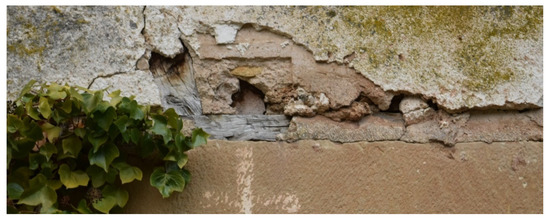
Figure 18.
Vegetation and lichens on a rendered half-timbered wall in Paúl (Alava).

Figure 19.
Analysis of the occurrence of vegetation in the half-timbered walls studied: (a) presence of vegetation depending on the infill material variant; (b) presence of vegetation depending on the type of rendering identified.
3.2.2. Mold and Lichens
The constant presence of humidity also favours the proliferation of fungi, mold, and lichens, both in the timber and the earth infill (Figure 18). This type of phenomenon tends to appear in north-facing walls or walls which receive very few hours of exposure to direct sunlight, focusing especially on areas where the geometrical and constructive configuration causes damp to accumulate.
Their presence and spread favours the accumulation of damp in earth infill, hampering the cohesion of the walls and facilitating the disaggregation of the surface [11], while some can also segregate organic acids affecting the chemical composition of the clay particles. In the case of timber, mold and chromogenic fungi only lead to a change of colour as they feed on reserve substances without affecting the structural function [19].
The incidence of this type of degradation in relation to the material variants is quite homogeneous and was detected in 61% of monolithic infills, in 51% of brick infills, and in 43% of light screens (Figure 20a). As with damp stains, this reduction of incidence in the light screens may be due to the layout of the construction which permits better ventilation and water evaporation.
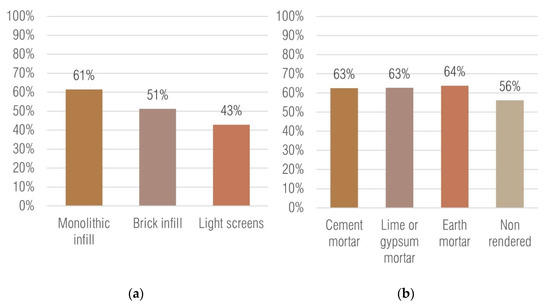
Figure 20.
Analysis of the occurrence of mold and lichens in the half-timbered walls studied: (a) presence of this pathology depending on the material variant of the infill; (b) presence of vegetation depending on the types of rendering identified.
The presence of renderings could influence the accumulation of damp, which in turn encourages the proliferation of these microorganisms. At the same time their smooth homogeneous surface increases the visual impact of this type of weathering. In the sample studied, mold and lichens appear slightly more often in the rendered cases than in the non-rendered cases (Figure 20b).
3.2.3. Xylophagous Insects
As they are built with timber, half-timbered walls are susceptible to attack from xylophagous insects, especially in areas where different factors such as geometry, exposure, or poor ventilation encourage damp (Figure 21).

Figure 21.
Attack by xylophagous insects at the meeting of wooden elements where moisture accumulates, in a half-timbered wall in Valdazao (Burgos).
This type of weathering was detected in 11% of the case studies (Figure 3), distributed homogeneously between material variants, in 10% of monolithic infills, in 10% of brick infills, and in 14% of light screens (Figure 22a). As damp is one of the factors increasing the proliferation of xylophagous insects, when cross-referencing both pathologies it was observed that at least a tenth of cases with damp also display defects caused by xylophagous insects (Figure 22b).

Figure 22.
Analysis of the incidence of the attack of xylophagous insects on the half-timbered walls studied: (a) presence of this pathology depending on the material variant of the infill; (b) combined presence of damp stains and xylophagous insects on the half-timbered walls studied based on the type of infill.
Given that degradations were identified through exterior visual analysis it was only possible to detect the presence of surface holes caused by insects with larva cycles such as anobids and cerambycids, and in a few occasions the internal galleries caused by termites when timber elements were broken or fragmented [27]. Anobid and cerambycid insects mainly cause damage to the external layers of timber without endangering its structural resistance. However, termites are photosensitive insects which feed on the interior core of the timber and are therefore much more difficult to detect and pose a greater risk to the structure. Their incidence may be even higher than observed, especially considering that the underground termite species Reticulitermes lucífugus Rossi is widely found in the Iberian Peninsula [28].
3.2.4. Rot
Rot is the result of the proliferation of xylophagous fungi which feed on certain components of the timber destroying the structure and therefore seriously reducing its loadbearing capacity (Figure 23). The most frequent types are cubical brown rot which feeds on cellulose, causing the timber to split and darken, the white or fibrous rot which feeds on lignin, resulting in a light fibrous appearance, and finally soft rot, which attacks certain cellulose components and softens the timber [29].

Figure 23.
Cubical brown rot in the lower part of a pillar in contact with the humidity of the ground, in a half-timbered wall in Ages (Burgos).
This type of pathology was detected in 25% of case studies (Figure 3), evenly distributed between the material variants (Figure 24a). As with xylophagous insects, rot requires a certain degree of humidity. It was observed that approximately a third of cases with damp in the infill eventually developed rot processes in the timber (Figure 24b), with a higher incidence in the monolithic infills which tend to accumulate damp and a lower incidence in the light screens, whose structure allows better breathability and evaporation of water.
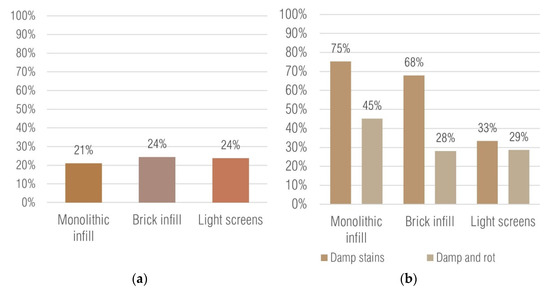
Figure 24.
Analysis of the occurrence of rot in the half-timbered walls studied: (a) presence of this pathology depending on the infill material; (b) combined presence of damp stains and rot in the half-timbered walls studied depending on the type of infill.
3.3. Degradations Due to Anthropic Causes
This type of weathering refers to those derived from actions caused by humans, whether directly with active participation as in the case of acts of vandalism or the installation of inappropriate elements or indirectly with actions resulting from the omission of the necessary maintenance for the correct conservation. As already stated, maintenance is the best guarantee for this type of construction, but these maintenance actions are not always suitable in the current context when the associated ways of life have changed, as has constructive culture due to industrialization [30].
Among these types of defects, pathologies involving unsuitable elements and materials are more frequent than pathologies related with changes in the structure (Figure 3), for example the replacement of formwork sections (Figure 25) or the incorrect addition of openings (Figure 26).

Figure 25.
Replacement of the monolithic traditional filling with industrial brick and modifications of the timber structure, in a half-timbered wall in Pancorbo (Burgos).

Figure 26.
Addition of openings and installation of unsuitable elements such as shutter boxes and ventilation chimneys in al half-timbered wall in Poza de la Sal (Burgos).
3.3.1. Replacement of Formwork Sections
The combination of the timber framework and the earth infill entails a discontinuous construction which can cause poor adherence between both elements. Consequently, when serious weathering of atmospheric or biological origin appear in the infill, compromising the stability of the structure, there is usually a partial or total collapse of the infill. Equally, when there is an unsuitable design for the roof support or the foundations causing the outwards thrust of the wall, the ductility of the timber usually allows it to adapt to these new surrounding conditions, but the loosening of the structure means the infill usually spills out of the wall, becoming more easily detached.
Whether due to lack of maintenance or deliberate demolition, the replacement of formwork sections was found in 15% of case studies (Figure 3). Analysis of the influence of this anthropic degradation based on the material variants shows a higher incidence in half-timbered walls with monolithic and brick infills (Figure 27a). A greater occurrence was detected in the brick infills, possibly because the monolithic infills are based on poured earth, so that the earth mass adapts, connects, and adheres better to the timber structure. Nevertheless, it is not uncommon for traditional infill to be replaced with industrial brick infill and cement mortar which could generate material and structural compatibility problems, as well as affecting appearance.

Figure 27.
Analysis of the occurrence of weathering entailing structural changes in the walls studied: (a) presence of replacements of infill in some formwork sections depending on the material variant of the infill; (b) presence of improperly added openings depending on the material variant of the infill.
3.3.2. Addition of Openings
The construction process for half-timbered walls should consider the position and configuration of openings from the very start in order to establish the geometry of the timber [31], adding elements such as horizontal breaks and upright posts to delimit the openings. When openings are added following the construction of the structure, this can be done by simply eliminating the infill of one of the formwork sections. However, current comfort and habitability standards have led to the addition of larger openings, requiring timber elements to be cut or eliminated and introducing discontinuity to the loadbearing plan, affecting structural behaviour.
Therefore, the informal addition of openings detected in 30% of the sample studied (Figure 3) affects not only the aesthetics of the building’s traditional appearance but in the long run can also be linked to structural degradation processes. These additions were identified more frequently in the monolithic infills (Figure 27b), normally associated with simpler geometries with less space between upright posts, so that several vertical elements are broken to make the opening. The limited influence of this pathology in woven walls may be due both to its structural configuration and to its more frequent use in agricultural buildings or in rooms such as attics and lofts.
3.3.3. Unsuitable Elements
The installation of cables, signs, and other unsuitable elements is a common action, which often is not in keeping with the features of the buildings [25]. In addition to altering the appearance of the building, these elements are often carelessly placed, breaking constructive elements by attaching industrialized materials. In the sample studied this is the most common anthropic pathology, found in 48% of cases (Figure 3). The occurrence of these installations is far greater in half-timbered walls with monolithic infills and brick infills than in woven walls with light screens (Figure 28a).

Figure 28.
Analysis of the occurrence of weathering involving incompatible elements and materials: (a) presence of unsuitable elements depending on the material variant of the infill; (b) presence of repairs using unsuitable materials depending on the material variant of the infill.
It was observed that cables were usually installed following the geometry of the timber structure (Figure 29), possibly for appearance’s sake and as elements are more easily attached to timber. In 93% of cases where the cables are visible, the timber structure has been followed without a need to perforate the infill which could cause cracks or fissures. However, attaching the cables to the timber causes the appearance of points which let water in, contributing to degradation when metal elements become rusty.

Figure 29.
Cables installed following the geometry of the timber structure in a half-timbered wall in Santa Cruz de Moya (Cuenca).
3.3.4. Repairs with Unsuitable Elements
Repairs using incompatible industrial materials can speed up the degradation of half-timbered walls. This is the second most common anthropic pathology in the sample and is found in 38% of cases (Figure 3). These repairs tend to be patching, reintegrating, and rejointing using cement mortar in the most damaged sections of the infill (Figure 30), or introducing industrial brick as jambs when adding new openings. Cement mortar was also found to e used to build a slight slope at the point where the lower wall and the half-timbered wall meet, causing an accumulation of water. The use of cement also makes it harder for walls to breathe, favouring the accumulation of damp inside and potentially leading to efflorescence and problems of chipping and gaps due to the difference in rigidity compared to traditional materials [25]. The incidence of these factors depending on material variants is much greater in walls with monolithic infill than in walls with brick infill or light screens (Figure 28b). This may be due to the fact that with brick infill the formwork section is completely replaced with an industrial brick infill, while on the whole maintenance actions are less common in light screens so that the use of industrial materials is less frequent in these repairs.

Figure 30.
Rejoint of a fabric filling of a half-timbered wall in Garganta la Olla (Cáceres).
3.4. Discussion about Material Degradation Processes
Thanks to the data collected on the state of material conservation of the 268 half-timbered walls with earth infill conclusions were reached on the occurrence and causes of the most common material degradation processes, and 15 types of material degradations were identified.
It is worth noting the erosion of earth infill which in almost half the cases has evolved to cause a loss of volumetry, as well as the presence of damp stains in almost 75% of the sample, which in the long term favours the disaggregation and erosion of the infill, the surface deterioration of timber and the proliferation of xylophagous insects and rot. Other material weathering of the timber caused by atmospheric agents, such as chromatic alteration, dehydration, and deteriorating cracks, are also commonly found in the sample studied, but their effect depends greatly on the presence of renderings, and entails a greater risk of damp accumulation and the consequent rot and proliferation of xylophagous insects.
Although lichens are the most common biological weathering, their main effect is surface disaggregation, while rot and attack of xylophagous insects are far more relevant to the material and structural conservation of half-timbered walls. Maintenance is the best guarantee for the conservation of this type of construction but in the current situation, where associated ways of life have been lost and there has been a change of constructive culture due to industrialization, maintenance actions are not always suitable.
Among the degradations due to anthropic causes it is worth highlighting the replacement of the infill of the formwork sections with industrial brick infill, adding openings that could alter the structural layout of the wall and the interventions using improper elements and materials, such as adding cables or using cement mortar for repairs, rejointing, and patching.
Half-timbered walls are not only affected by the processes of material degradation characteristic of both timber and the earthen constructive techniques, but they also present anthropic degradations arising from the lack of valorization and understanding of this type of technique. Thus, this analysis should be complemented by the study of structural degradation processes and transformation dynamics in order to propose guidelines for conservation.
4. Conclusions
Any intervention on an historical building should be based on a complete knowledge of it and its state of conservation, for which purpose a general awareness of the most common material degradation processes of each construction technique could be valuable.For half-timbered walls with earth-infill in the Spanish context, the material degradation processes observed are mainly caused by direct and constant exposure to atmospheric agents. Their effects and risk are amplified by the disappearance of protective elements due to lack of maintenance, such as renderings, eaves, and plinths. Therefore, for its material conservation it is essential to promote correct maintenance, both of the half-timbered wall itself and of the renderings, eaves, and plinths that act as protective elements. Preventive maintenance and conservation actions would reduce the incidence and accumulation of water, which eventually leads to erosion and loss of filler, as well as timber rot and proliferation of xylophagous insects.
At the same time, the lack of knowledge and appreciation of this type of techniques has contributed to the development of spontaneous interventions, without any consideration of the material, chemical, or structural compatibility or the patrimonial value of these walls. Therefore, it would also be necessary to promote its appreciation among the population and increase the knowledge of this type of techniques among specialists, so that their inhabitants want to preserve it and the technicians know how to preserve it. It would also be important to reduce the scepticism concerning their quality and capacity to adapt to current uses and comfort standards [32], as it could have influenced the owners in their investment for maintenance and conservation.
Furthermore, half-timbered walls are part of the cultural identity of many communities. The traditional buildings that still stand throughout Spain are the material reflection of a cultural heritage that is at risk, threatened by globalisation and the loss of associated building knowledge. Vernacular architecture was traditionally built using construction techniques made by local craftsmen or by the inhabitants themselves, who passed on their knowledge over generations and adjusted it to specific climatic conditions and materials. However, in recent decades there has been an imbalance in these conditions, which puts the survival of this heritage at risk and makes its recovery and conservation necessary.
For this reason, their protection should extend beyond the material object, also encompass the associated traditional knowledge and crafts, the related forms of life, the landscapes generated, the strategies for sustainability and adaptation to the environment, and so on. To this purpose, it is important to have legislation that protects historical buildings and regulates the interventions on them, especially considering that only 24 of the 83 localities where this type of buildings have been detected have some sort of protective regulations. It is also necessary to establish certain regulations on the construction of new buildings in historical sites with presence of these techniques, above all to avoid the distortion or misinterpretation of traditional techniques (Figure 31).

Figure 31.
The difference between a traditional brick wall and a new building that aims to follow the same aesthetic, in Madrigal de la Vera (Cáceres).
Author Contributions
Conceptualization, A.H.E.; C.M. and M.D.; methodology, M.D. and A.H.E.; software, A.H.E.; validation, A.H.E.; formal analysis, A.H.E.; investigation, A.H.E.; resources, C.M.; F.V.L.-M.; M.D. and A.H.E.; data curation, A.H.E.; writing—original draft preparation, A.H.E.; writing—review and editing, F.V.L.-M. and C.M.; visualization, A.H.E.; supervision, C.M.; F.V.L.-M. and M.D.; project administration, C.M. and F.V.L.-M.; funding acquisition, C.M. and F.V.L.-M. All authors have read and agreed to the published version of the manuscript.
Funding
This work is part of the research project “La arquitectura de tierra en la Península Ibérica: Estudio de los riesgos naturales, sociales y antrópicos y estrategias de intervención e incremento de la resiliencia” Risk-Terra (ref. RTI2018-095302-B-I00; main researchers: Camilla Mileto y Fernando Vegas), funded by the Spanish Ministry of Science, Innovation and University. This research has been developed within a doctoral thesis funded by the Spanish Ministry of Science, Innovation and University (Ref. FPU18/01596).
Acknowledgments
The identification and location of many case studies has been possible thanks to the earlier research project “La restauración y rehabilitación de arquitectura tradicional de tierra en la Península Ibérica. Líneas guía y herramientas para una intervención sostenible” SOStierra (ref. BIA 2014-55924-R, main researchers: Camilla Mileto y Fernando Vegas) funded by the Spanish Ministry of Economy and Competitiveness.
Conflicts of Interest
The authors declare no conflict of interest. The funders had no role in the design of the study; in the collection, analyses, or interpretation of data; in the writing of the manuscript, or in the decision to publish the results.
References
- Oliver, P. Conservation and Continuity. In Built to Meet Needs: Cultural Issues in Vernacular Architecture; Elsevier—Architectural Press: Amsterdam, The Netherlands, 2006. [Google Scholar]
- Mileto, C.; Vegas, F.; Cristini, V.; García-Soriano, L. The Research Project “Earthen Architecture in the Iberian Peninsula: Study of Natural, Social and Anthropic Risks and Strategies to Improve Resilience (Risk-Terra)”. Objectives and First Methodology. Int. Arch. Photogramm. Remote. Sens. Spat. Inf. Sci. 2020, 871–876. [Google Scholar] [CrossRef]
- Mileto, C.; Vegas, F.; Cristini, V.; García Soriano, L. SOSTierra Project. itial Results. In Vernacular and Earthen Architecture: Conservation and Sustainability; Mileto, C., Vegas, F., García-Soriano, L., Cristini, V., Eds.; Taylor & Francis Group: London, UK, 2018; pp. 185–190. [Google Scholar]
- Mileto, C.; Vegas, F.; Vendrell, M.; García-Soriano, L. Degradation mechanisms: Phenomena and causes. In The COREMANS Project. Intervention Criteria for Earthen Architecture; Ministerio de Economía Cultura y Deporte, Gobierno de España: Madrid, Spain, 2017; pp. 78–86. [Google Scholar]
- De Hoz Onrubia, J.; Maldonado Ramos, L.; Vela Cossío, F. Diccionario de Construcción Tradicional Con Tierra; Editorial Nerea: San Sebastián-Donostia, Spain, 2003. (In Spanish) [Google Scholar]
- Lasheras Merino, F. Patología de la Construcción Madera [Timber Construction Pathology]. In Tratado Técnico Jurídico de la Edificación y el Urbanismo: Patología de la Construcción y Técnicas de Intervención; Humero Martin, A.E., García Gamallo, A.M., Eds.; Aranzadi, Thomson Reuters: Cizur Menor, Navarra, Spain, 2009; Volume 1, pp. 801–862. (In Spanish) [Google Scholar]
- Escobar, A.H.; Diodato, M.; Vegas, F.; Fernández, S.M. Approximation to the Use of Half-Timbered Walls with Earth Infill in Spanish Traditional Architecture. Int. Arch. Photogramm. Remote. Sens. Spat. Inf. Sci. 2020, 1033–1040. [Google Scholar] [CrossRef]
- Hueto-Escobar, A.; Diodato, M.; Mileto, C.; Vegas López-Manzanares, F. Estudio Tipológico-Constructivo de Los Muros Entramados en España: Metodología de Estudio [Typological-Constructive Study of Half-Timbered Walls in Spain: Proposal of Methodology]. In Conservación Sostenible del Paisaje: Tierra y Agua, Proceedings of the 19 Seminario Iberoamericano de Arquitectura y Construcción con Tierra—SIACOT 2019, Oaxaca, México, 15–18 October 2019; Neves, C., Salcedo Gutierrez, Z., Borgés Faria, O., Eds.; Fundadal, Proterra: San Salvador, El Salvador, 2019; pp. 369–379. (In Spanish) [Google Scholar]
- Adhemar; de Arenas, D.L.; Cabanie; Douliot; Emy; Fourneaux; Frezier; Hassenfratz; Krafft; Merly; et al. Earht as construction material. In The COREMANS Project. Intervention Criteria for Earthen Architecture; Ministerio de Economía Cultura y Deporte, Gobierno de España: Madrid, Spain, 2017; pp. 160–164. [Google Scholar]
- Desch, H.E.; Dinwoodie, J.M. Degradation of Timber in Service. In Timber: Structure, Properties, Conversion and Use, 7th ed.; Macmillan Press: London, UK, 1996; pp. 233–237. [Google Scholar]
- Feilden, M.B. Structural Elements III: Walls, Piers and Columns. In Conservation of Historic Buildings, 3rd ed.; Eisever—Architectural Press: Oxford, UK, 2003; pp. 61–78. [Google Scholar]
- Cornerstones Community. Adobe Conservation. A Preservation Handbook; Sunstone Press: Santa Fe, NM, USA, 2006. [Google Scholar]
- Desch, H.E.; Dinwoodie, J.M. Moisture in Wood. In Timber: Structure, Properties, Conversion and Use, 7th ed.; Macmillan Press: London, UK, 1996; pp. 81–95. [Google Scholar]
- Gómez-Patrocinio, F.J. Arquitectura Tradicional de Tierra en España. Caracterización Constructiva, Fenómenos de Degradación y Dinámicas de Intervención [Traditional Earthen Architecture in Spain. Constructive Characterization, Degradation Phenomena and Intervention Dynamics]. Ph.D. Thesis, Universidad Politécnica de Valencia, Escuela Técnica Superior de Arquitectura, Valencia, Spain, 2018. (In Spanish). [Google Scholar]
- Adhemar; de Arenas, D.L.; Cabanie; Douliot; Emy; Fourneaux; Frezier; Hassenfratz; Krafft; Merly; et al. Degradation causes. In Terra Incognita: Discovering & Preserving European Earthen Architecture; Tervuren Argumentum Ediçóes, Culture Lab Éditions: Lisboa, Portugal, 2008. [Google Scholar]
- Gómez-Patrocinio, F.J.; Camilla, M.; García-Soriano, L.; Vegas López-Manzanares, F. Material Weathering and Structural Damage in Historic Adobe Constructions in Spain: Preliminary Results of a Quantitative Approach. Stud. Conserv. 2020, 65, 450–464. [Google Scholar] [CrossRef]
- Martínez Nuñez, L.; Moreno García, J.V.; Chazarra Berbabé, A.; Gallego Abaroa, T.; Avello Miranda, M.; Botey Fullat, R. Mapas de Riesgo: Heladas y Horas Frío en la España peninsular (Periodo 2002-2012) [Risk maps: Frost and Cold Hours in Peninsular Spain (Period 2002-2012)]; Ministerio de Agricultura, Alimentación y Medio Ambiente, Agencia Estatal de Meteorología: Madrid, Spain, 2015. (In Spanish) [Google Scholar]
- Gómez-Patrocinio, F.J.; García-Soriano, L.; Balaguer Garzón, L. Examination of structural decay processes in adobe vernacular architecture in Spain. In Vernacular and Earthen Architecture: Conservation and Sustainability; Mileto, C., Vegas, F., García-Soriano, L., Cristini, V., Eds.; Taylor & Francis Group: London, UK, 2018; pp. 129–134. [Google Scholar]
- Reinprecht, L. Abiotic Degradation of Wood. In Wood Deterioration, Protection and Maintenance; Wiley Blackwell: West Sussex, UK, 2016; pp. 28–61. [Google Scholar]
- Larsen, K.E.; Marstein, N. Like seasoned timber, never gives: The durability of wood as a building material. In Conservation of Historic Timber Structures. An ecological approach; Butterworth-Heinemann, Series in Conservation and Museology: Oslo, Norway, 2016; pp. 79–91. [Google Scholar]
- Maldonado Ramos, L.; Vela Cossío, F. Arquitectura popular en el Valle del Tiétar [Popular architecture in the Tiétar Valley]. Rev. Narria Estud. Artes Costumbres Pop. 1996, 75, 1–7. (In Spanish) [Google Scholar]
- Desch, H.E.; Dinwoodie, J.M. Strength, Elasticity and Toughness of Wood. In Timber: Structure, Properties, Conversion and Use, 7th ed.; Macmillan Press: London, UK, 1996; pp. 102–128. [Google Scholar]
- McCaig, I.; Ridout, B. English Heritage practical building conservation Timber; English Heritage: London, UK, 2012. [Google Scholar]
- Arias y Scala, F. Carpintería Antigua y Moderna, 3rd ed.; Nácente, F., Ed.; Colegio Oficial de Arquitectos de Galicia: Barcelona, Spain, 1893. [Google Scholar]
- Vegas, F.; Mileto, C. Aprendiendo a Restaurar. Un Manual de Restauración de la Arquitectura Tradicional de la Comunidad Valenciana [Learning to Restore. A Manual for Restoring the Traditional Architecture of the Valencian Community], 2nd ed.; Generalitat Valenciana: Valencia, Spain, 2014. (In Spanish) [Google Scholar]
- Feilden, M.B. Botanical, biological and microbiological causes of decay. In Conservation of Historic Buildins, 3rd ed.; Eisever—Architectural Press: Oxford, UK, 2003; pp. 133–139. [Google Scholar]
- Santa Cruz-Astorqui, J.; Del Río, M. Structural behaviour model of timber-framed walls in the nineteeth century in Spain. Inf. Constr. 2014, 66, e048. [Google Scholar] [CrossRef][Green Version]
- Arriaga Martitegui, F.; Peraza Sánchez, F.; Esteban Herrero, M.; Bobadilla Maldonado, I.; García Fernández, F. Intervención en Estructuras de Madera [Intervention in Timber Structures]; AITIM: Madrid, Spain, 2002. (In Spanish) [Google Scholar]
- Reiprecht, L. Biological Degradation of Wood. In Wood Deterioration, Protection and Maintenance; Wiley Blackwell: West Sussex, UK, 2016; pp. 91–125. [Google Scholar]
- Feilden, M.B. The Work of the Conservation Architect. In Conservation of Historic Buildings, 3rd ed.; Eisever—Architectural Press: Oxford, UK, 2003; pp. 189–333. [Google Scholar]
- García Grinda, J.L. Arquitectura Popular de Burgos [Popular Architecture of Burgos]; Colegio Oficial de Arquitectos: Burgos, Spain, 1988. (In Spanish) [Google Scholar]
- Bei, G. Earth building conservation. Does It Produce a High Quality Building Environment? In Proceedings of the International Conference Conservation in Changing Societies, Heritage and Development; Raymond Lemaire International Centre for Conservation: Leuven, Belgium, 2006; pp. 425–430. [Google Scholar]
Publisher’s Note: MDPI stays neutral with regard to jurisdictional claims in published maps and institutional affiliations. |
© 2021 by the authors. Licensee MDPI, Basel, Switzerland. This article is an open access article distributed under the terms and conditions of the Creative Commons Attribution (CC BY) license (http://creativecommons.org/licenses/by/4.0/).